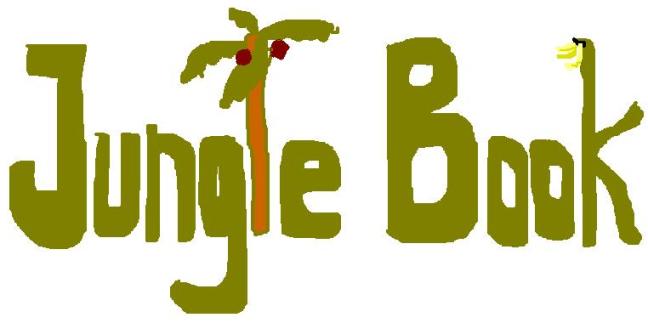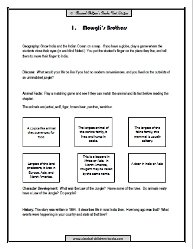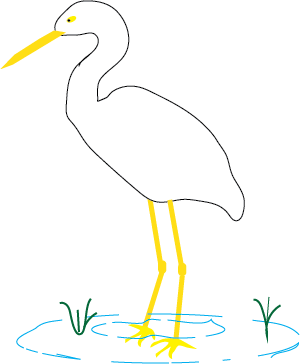
Jungle Book Unit Study
Our Jungle Book Unit Study will make your literature unit roar as students explore this classic book by Rudyard Kipling. Older and younger students may enjoy participating in the Jungle Book unit study as well.

Free Unit Study Download Below
Planning Your Jungle Book Unit Study
This is a series of fictitious stories that take place in India in the late 1800's. The three first stories are about the boy, Mowgli, who is raised in the jungle by a pack of wolves. Although a number of films have been made based on this story, the literature is slightly different. The Disney movie in particular is familiar to many pre-school children, while the actual book is for an older audience.The chapters are as follows:
- 1. Mowgli's Brothers - Mowgli joins the wolf pack
- 2. Kaa's Hunting - The python Kaa helps Mowgli escape from the bandarlog
- 3. Tiger! Tiger! - Mowgli's life in the village and the demise of Sher Khan
- 4. The White Seal - A legend of a white seal from the Bering Sea
- 5. Rikki Tikki Tavi - A mongoose saves a family from a cobra
- 6. Toomai of the Elephants -A boy witnesses an elephant ritual never before seen by humans
- 7. Her Majestys Servants - Different animals used in the Indian military discuss their roles
Seven Day Jungle Book Unit Study
Read all 7 chapters. The story of Mowgli will be the first three days, followed by the other four nature stories.Five Day Jungle Book Unit Study
The five day study includes these chapters- Mowgli - Chapters 1-3
- Rikki Tikki - Chapter 5
- Majesty's Servants - Chapter 7
Four Day Jungle Book Unit Study
This study includes all three of the Mowgli stories AND the story of Rikki Tikki, the second most popular story in the book.- Mowgli - Chapters 1-3
- Rikki Tikki - Chapter 5
Three Day Jungle Book Unit Study
The three day study includes only the stories of Mowgli which are told in the first three chapters of the book.The Parts of the Jungle Book Unit Study
Background InformationIndia is an eastern country north of the Indian Ocean. At the time these stories were written, India was an English Colony. In the story, there are references to white men. At that time, virtually all the white people in Indian were British military men or diplomats and were viewed as people with power and greater technology. The people living in the native villages had brown skin. India is no longer a colony, and that distinction is long outdated.
Geography
Be prepared with a world map.
History
Students should realize that the culture depicted was historical, and India is currently a modernized country. Just as pirates no long sail the seas, cowboys are not fighting in the Wild West; people in Indian villages no longer live in grass huts or have their children snatched by tigers from the jungle.
Animal Facts - Go Fish
For some of the stories, it is helpful for the students to mentally differentiate the different animals and their roles in the story. To do this, we recommend having students make cards for the different animals. We have small fact cards for different chapters that can be cut out and taped or glued onto index cards. As an alternative, older students may research and write their own fact cards.
Make a minimum of two cards for each animal. You can make two copies of our cards, or use one copy and have them develop another fact for the second.
The cards can then be used to play a game of Go Fish. This is an optional activity to add interest to the students.
Character Development
Discussion questions for each chapter are asked.
Poetry
Each chapter has at least one poem. Students may enjoy hearing these poems read, and discussing the meaning. Poetry also gives students an opportunity to read poems orally themselves to strengthen their own reading skills and recognize the contribution of the poem's rhythm.
Room Decorations
For a dramatic touch, you may like to make a jungle environment in your room. Vines can be made by using rolls of brown paper (the kind paper grocery bags were made out of.) Newspaper can be used as well. Roll long pieces of the paper to make vines. They can be taped to the ceiling, and draped down, the way crepe paper is traditionally draped for birthday parties.
Jungle Snacks
Try different snacks for different days.
- Bananas
- Animal crackers (jungle animals, of course)
- Trail mix
- A real coconut - open it and drink the coconut juice
- Shredded coconut - compare to the whole coconut.
Nature Study
Nature study usually involves investigating how animals and plants interact in their environment. Obviously, seals don't live in jungles, and tigers don't live in Alaska. Ask the students how a particular environment is suited for each animal.
- What plant, and animal life is there that the animal needs?
- What features of the animals body allow it to live in that area?
Mowgli's Brothers
Chapter One of the Jungle Book Unit Study
GeographyShow India and the Indian Ocean on a map. If you have a globe, play a game where the students close their eyes (or are blind folded.) Put the student's finger on the location they live, and tell them to move their finger to India.
Discuss
What would your life be like if you had no modern conveniences, and you lived on the outskirts of an uninhabited jungle?
Animal Facts
The printed unit study (link at the top of this page) has one zoology fact for each of these animals:
- jackal
- wolf
- tiger
- brown bear
- panther
- sambhur
The animal fact cards can be used to play Go Fish. See the instructions at the beginning of the Jungle Book Unit Study.
Character Development
- What was the Law of the Jungle?
- Name some of the rules.
- Do animals really have a Law of the Jungle?
- Do people?
This story was written in 1894. It describes life in rural India then. How long ago was that? What events were happening in your country and state at that time?
Kaa's Hunting
Chapter Two of the Jungle Book Unit Study
SnacksThis is a good day for the bananas since the monkeys are a large part of today's story. (They are not very popular, however.)
Animal Facts
Add python and cobras to your animal fact cards. Students can play Go Fish with the old and new Animal Fact cards as often as desired.
The facts for those cards are on the printed pages which can be downloaded (link at the top of this page.)
Snakes
What snakes are in your area? Predict what would happen if all of these snakes were in a cage together.
Archeology
- What happens to abandoned towns and cities?
- Would you like to be an archeologist?
- Would this city have been interesting to an archeologist?
Character Development
Describe the personality of the Bandar log? Are they proud? Are they jealous?
Pride and jealousy are often two sides of the same coin. How can you see that in these animals?
Poetry
Have fun reading the Road Song of the Bandar Log. It is the poem at the end of the chapter.
Tiger! Tiger!
Chapter Three of The Jungle Book Unit Study
IntroductionIn this chapter, Mowgli goes to live with humans in the village. In the end, they reject him. Don't tell the students that will happen before this chapter is read.
However, do introduce the students to the concept of the caste system before reading the chapter.
Caste
India used to have a caste system. A person was born into a particular group, and they had to stay within that group all of their lives. They could not marry anyone in a higher or lower caste. Everyone knew what everyone else’s caste was, and were required to treat people differently depending on the caste. The caste determined what clothes people would wear and what jobs they would do.
Before reading the chapter, explain that Mowgli did not understand the caste system, but everyone else did. Mowgli has grown up in the jungle. He did not try to treat people better because they were from a higher caste, or refuse to help them if they were in a lower caste.
Tigers
Tigers are extremely interesting creatures. Do an internet search for more information. Or watch a documentary from the library.
Antagonist and Protagonist
- Sher Khan and the jackal are the antagonist.
- Think of other animal stories and movies.
- List stories (or movies) where different animals have been either the antagonist or protagonist.
- If you were to write a story with these animals, which ones would be antagonists or protagonists?
Mowgli had learned to control his temper when he lived in the jungle. How does this help him now?
Think about it
Why was Mowgli rejected?
Answer: He did not obey the caste. He was different. The people did not understand his relationship with the animals.
Even in countries that don’t have a legal caste system, people are often rejected for many of the same reasons.
The White Seal
Chapter four of The Jungle Book Unit Study
IntroductionThe stories of Mowgli are finished. The last four chapters are a series of stories with animals as the unifying theme.
The story of The White Seal is the only story that does not take place in India. For this reason, it is often not included in some unit studies of The Jungle Book.
The narrative of this story is quite interesting in terms of point of view. It may be a more advanced concept than some students may be able to grasp. It is written in first person with a single reference to "me" by an unknown narrator.
What students should realize is that the story is told by Limmershin. He is a bird that witnesses the story, but has no place in it.
Before the story is read - Give the following explanation:
This story is about seals. The story is told by a bird named "Limmershin." Limmershin has no part in the story but he tells it. After we read the story, tell me why you think the author chose to have a bird be the one who tells the story.
Answer - Birds' eye view. No one else could have witnessed it.
Animal Facts
Add seals to the animals that have fact cards. One fact is listed on the printed unit study pages (link above).
Geography
- Novastoshnah - The North East Point of an island in the Bering Sea by Alaska.
- Lukannon - One of the Aleutian Islands stretching out south of Alaska
- Equator - Warmest place on the globe since it is closest to the sun
- Pacific Ocean - The seals migrate north and south in the Pacific Ocean
There is a lullaby at the beginning of the chapter, and the seals' "National Anthem" at the end.
Rikki Tikki Tavi
Chapter Five of The Jungle Book Unit Study
This is a famous story of a wild mongoose who becomes adopted by a British family living in India.
A mongoose is a natural predator of snakes. He soon becomes enemies to a pair of talking cobras who are determined to kill him and his new adopted family. Not the best choice of stories for children who may get nightmares from snakes. However, most children enjoy the high action of the story.
After a few scary scenes, the good animals win, thanks to a brave a loyal little mongoose.
Animal Facts
Of course, we will add mongoose to our animal fact cards. One fact is included on the printed unit study (link at the top of this page.)
The group can continue playing Go Fish with their Animal Fact cards, as well as adding more facts to them.
Let's get better acquainted with a mongoose
Do an internet search to look up pictures of a mongoose. There are also some interesting clips on YouTube that capture the show-down between a cobra and mongoose. (The mongoose wins - but double check it before showing the kids.)
Re-read the second paragraph of the story slowly to understand what he looked like.
Draw a picture of a mongoose.
Animal sounds
What do you think the call "Rikki Tikki" would sound like?
- Think of other animal sounds.
- Bob white and katydids are named after the animals' call.
- Can you think of other sounds?
Writing
Make a list of the advantages and disadvantages of having a mongoose as a pet.
Poetry
Darzee's Chant at the end of the story.
- Read this several times to get the rhythm.
- What does this line mean: "Death in the garden is dead."
- Describe any other phrases the student needs help understanding.
The first poem at the beginning of the story has a more difficult rhythm and meaning.
It can be an interesting poem for two people to recite together.
Vocabulary
Bungalow - A cottage
Culture
- If you had been a British child 100 years ago, do you think you would want to move to India, as Teddy did?
- What would be the advantages of traveling to another country to live?
- The disadvantages?
Toomai of the Elephants
Chapter Six of The Jungle Book Unit Study
Introduction
Toomai is a young boy who is the fourth generation of elephant drivers in his family. The government owned elephant that he helps herd is Kala Nag, an old and loyal animal.
Kala Nag and his handlers are in a camp near the jungle, helping break in the new elephants recently caught by the elephant hunters. Some men notice that Toomai has a special way with the elephants, but his father is afraid he will also become an elephant hunter that catches wild elephants in the jungle. The father feels that his status as a mahout of the plains is superior.
One night,Toomai rides on Kala Nag's back as the old elephant breaks his chains and joins other elephants for a legendary dance of the elephants that no other human has witnessed.
Vocabulary
Mahout - a driver of elephants from India
Culture
The father is from the plains of India and looks down on the people from the jungle. How does that affect how he treats his son?
Answer: He is angry and worried his son might become an elephant hunter and live near the jungle.
Zoology
Mark a chart showing the difference between Indian and African elephants.
Hint: Africa is a larger country. African elephants have larger ears that are shaped like Africa.
Visit a zoo or watch a documentary on elephants.
Animal Rituals
The elephant dance is a legendary ritual that the author used to tell this story. Brainstorm other rituals of wild animals.
Domesticated vs. Wild animals
Read the poem of Kala Nag at the start of the story. What do you think domesticated animals remember about their former lives?
Her Majesty's Servants
Chapter Seven of The Jungle Book Unit Study
Introduction
Five different animals debate their roles in the military of India. They also compare who is bravest, and what makes them afraid.
- Mule
- Camel
- Horse
- Bullock (male cattle)
- Elephant
Military Animals Chart
Some students will naturally catch on to the meaning of the dialogue, and others will take longer to understand what the animals are talking about.
To assist students (without giving away the plot) a chart can be made which states "What I Can Do" at the top.
Divide the paper into five columns with the five species of animals listed at the top of each column. The student can stop and write during the story, or wait until the end. The purpose of the paper is to help them identify the species of animal, and understand what they are talking about.
Point of View
Kipling again developed another creative technique with his point of view in this story. This is first person dialogue, and the narrator is a human who overhears the animals talking. It is a very interesting and humorous way of presenting the story.
Animal Facts
The printed unit study (link above) has one animal fact each for the mule, camel, horse, bullock, and elephant.
These are more familiar animals to most students than a seal or mongoose, but some of the facts are still interesting.
Again, students can be encouraged to research and write their own facts about the animals for the Go Fish game.
Character Development
What does the elephant mean when it says he can "see inside your head?" (Answer: An elephant can think of what might happen.)
How does that help or hurt the elephant?
Think about it
- What makes the animals obey their masters and go to war?
- What makes the humans obey their leaders and go to war?
To complete your Jungle Book unit study, consider watching one or more films based on the story after the book has been read. Most of the films only include stories of Mowgli, and differ as to which episodes they include.
Download the Jungle Book Unit Study


All activities are on a printer-friendly download.













